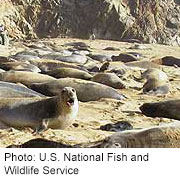
THURSDAY, May 16 (HealthDay News) — Flu-causing H1N1 virus has been discovered in marine animals — specifically seals — for the first time.
After the human H1N1 influenza pandemic began in 2009, researchers from the University of California, Davis, detected the virus in free-ranging northern elephant seals off the central California coastline.
“We thought we might find influenza viruses, which have been found before in marine mammals, but we did not expect to find pandemic H1N1,” study lead author Tracey Goldstein, an associate professor with the university’s One Health Institute and Wildlife Health Center, said in a university news release. “This shows influenza viruses can move among species.”
The H1N1 virus originated in pigs, and the resulting infection was known as swine flu.
“The study of influenza virus infections in unusual hosts, such as elephant seals, is likely to provide us with clues to understand the ability of influenza virus to jump from one host to another and initiate pandemics,” Adolfo Garcia-Sastre, director of the Global Health and Emerging Pathogens Institute at the Icahn School of Medicine at Mount Sinai, in New York City, said in the news release.
The new findings were published May 15 in the journal PLoS ONE.
In conducting the study, the researchers tested nasal swabs from more than 900 marine mammals from 10 different species off the Pacific Coast from Alaska to California between 2009 and 2011.
The H1N1 virus was identified in two northern elephant seals. Despite being infected with the virus, neither seal had any symptoms. Antibodies to the virus also were detected in 28 other elephant seals, suggesting exposure to the virus was widespread.
“H1N1 was circulating in humans in 2009,” Goldstein said. “The seals on land in early 2010 tested negative before they went to sea, but when they returned from sea in spring 2010, they tested positive. So the question is: Where did it come from?”
The infected seals were tracked by satellite. The researchers said exposure to H1N1 likely occurred while the seals were at sea foraging in the northeast Pacific Ocean off the continental shelf.
Since marine animals could be infected with H1N1 without showing any signs that they are sick, the researchers said their findings are particularly important for people who work with or handle marine animals. Taking precautions, such as wearing gloves, when working with these animals can help prevent the spread of disease both to and from humans, Goldstein said.
Today, the World Health Organization reports that H1N1 is under control and behaves as a seasonal virus.
More information
Visit the U.S. Department of Health and Human Services to learn more about H1N1.

